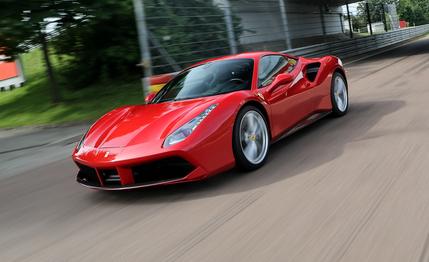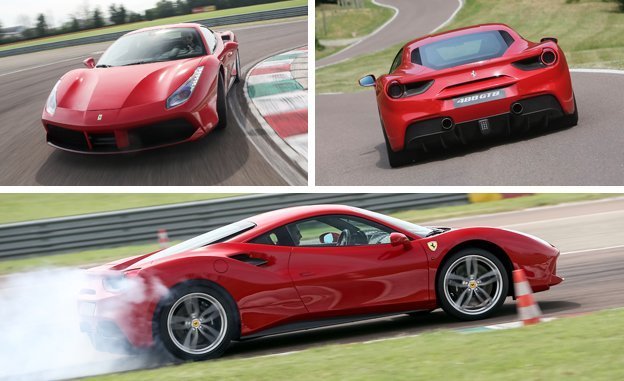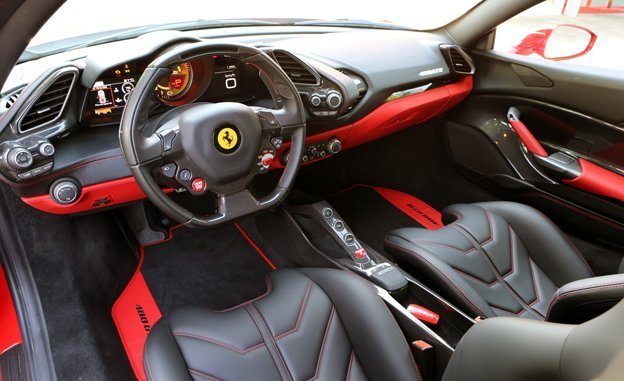 First Drive Review
First Drive Review
Turbos! Two of them—two big snails of swoosh—have invaded the holy sanctum of a Ferrari engine compartment, and life will never be the same. Next thing you know, the future CEO of a publicly traded Ferrari, one Juan Wang Lipschitz or somebody, will pull the sheet off an SUV with matching carbon-fiber Apple Watch and then, what the hell, we’re in Mad Max and the whole world is fried.
All right, let’s cut the crap. Ferrari’s bestselling model line, the mid-engine V-8, needed more power. It’s not Ferrari pushing this so much as the customers, those Ferragamo-shod masters of the universe who see progress only in numbers that go up. More power equals more speed equals more grip equals more, well, more. With Lamborghini and especially McLaren breathing down its neck, Ferrari felt it had to make a power and performance statement, but without turning the model into a big-bore gas hog. So it went shopping for turbos.
The result is the 488GTB, not a wholly new car at $242,737, but an evolution of the primarily aluminum 458 Italia that preceded it. The engine, called the F154, is a more powerful version of the 90-degree, four-cam, direct-injected unit in the new California T. Displacement shrinks from the old 458’s 4.5 liters to 3.9, but horsepower rises by 99 to 661 (about the same as the old Enzo), while torque, never the strong suit of a typical short-stroke Italian screamer, ramps up by 163 lb-ft to 561. Compared to the 4.5, the 3.9’s crankshaft sits lower by 3 millimeters and the engine’s center of gravity drops by 5 millimeters despite the high-mounted turbos.
These and other stats, which Ferrari engineers laid out, graph by mesmerizing graph in an exhaustive technical presentation at the Maranello factory before our first drive, show how different the 488 is in so many ways. First off, the 488GTB, which goes on sale in September, is one of the few new Ferraris in recent years that doesn’t have a nickname, such as Maranello or Fiorano or Italia.

According to Ferrari’s current CEO, Amedeo Felisa, since Ferrari was reverting back to the old practice of naming the cars by individual cylinder displacement—in the 488’s case, it’s actually 487.7 cubic centimeters—rather than total displacement plus cylinder count as in the 458, they might as well chuck the nickname convention, as well. Plus, all the obvious Ferrari locales had already been honored. So instead, Ferrari revives the GTB moniker to recall the 1975 original (and, presumably, GTS when the convertible 488 arrives).
More important, though, is the new 488’s métier. Ferrari is a company that has always seemed to operate by emotion and instinct. Like a chef who doesn’t use a recipe, Ferrari cooks its creations according to its own sense of purpose and history. While Ferrari doesn’t always get the dish exactly right, at least you know that its spicy meatballs come from the heart.
However, that seems ever so slightly less true of the 488GTB, an update of an existing Ferrari that is much ado about spreadsheet numbers, starting with the aforementioned power figures. There’s also the increased downforce, the millisecond improvements in throttle response and transmission shift times, the claimed 20 to 30 pounds shaved from the curb weight, and the greater lateral and longitudinal acceleration figures. All this detailed upgrading was expressed to journalists in concise statistics and percentages with accompanying graphs intended to prove that the 488 makes Ferrari once again the top stallion in the class.

After the briefing, we moved to the test track at Fiorano to be introduced to the new car itself, a pack of all-red examples of which were parked in front of Enzo Ferrari’s infield house as part of the de rigueur culture soak you get on press trips to Maranello.
As you can see, the new car looks familiar if a bit chunkier. The center section of the 488’s aluminum space frame basically carries over from the 458, with only the front and rear sections changed to accommodate the new powerplant and its greater need for airflow. Thus, the wheelbase stays static at 104.3 inches, while length and width increase only slightly, the latter due to a wider track.
Still, and despite efforts by the designers to squeeze in the body-side forms to create arrow-shaped sensuality around the two-tier intercooler ducts, some of the elegant svelteness of the 458 was sacrificed as Ferrari bulked up the rear to accommodate all the new plumbing. Hey, you wanted more power. Up front, the 458’s flexible catfish antennae were snipped off, replaced with a more generic-looking face (not necessarily a bad thing) with twin vertical airfoils to channel air underneath the car, plus a winged underbite like on the F12 that sluices more air into the larger nose radiators.
Wind-tunnel work produced new forms, such as curved air gates attached to the flat bottom and rear diffuser to enhance underbody low-pressure zones for optimum downforce. Ferrari calls the simple air slot aft of the rear glass that tunnels through the tail a “blown spoiler,” and it replaces a more common solution such as a lip spoiler or a motorized airfoil. Indeed, the only active aero element is a flap in the rear diffuser that tilts down at speed to disrupt drag-inducing eddy currents. Even the door handles have been reshaped into little winglets to channel air into the intercoolers.